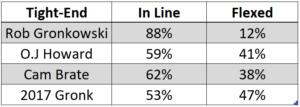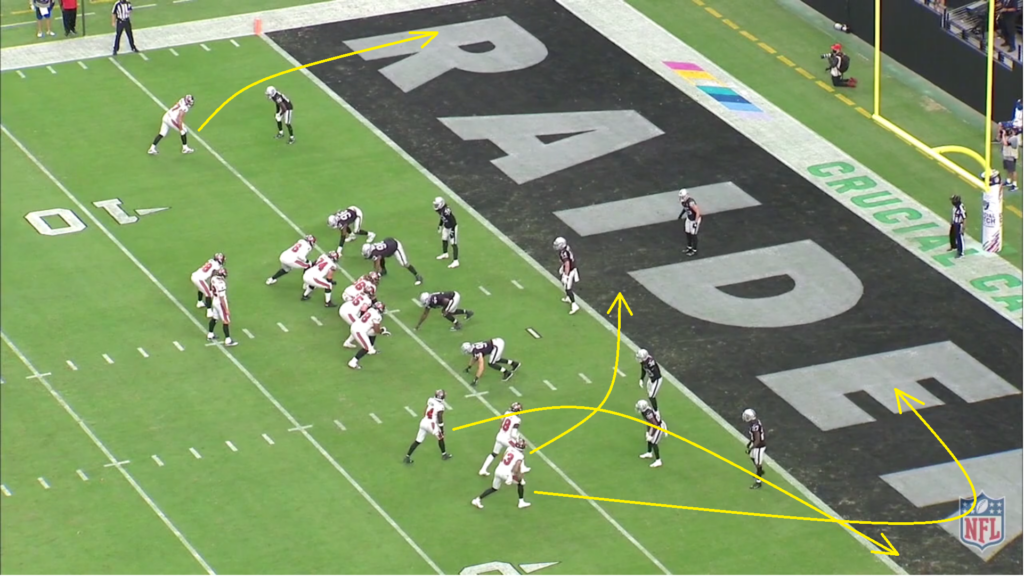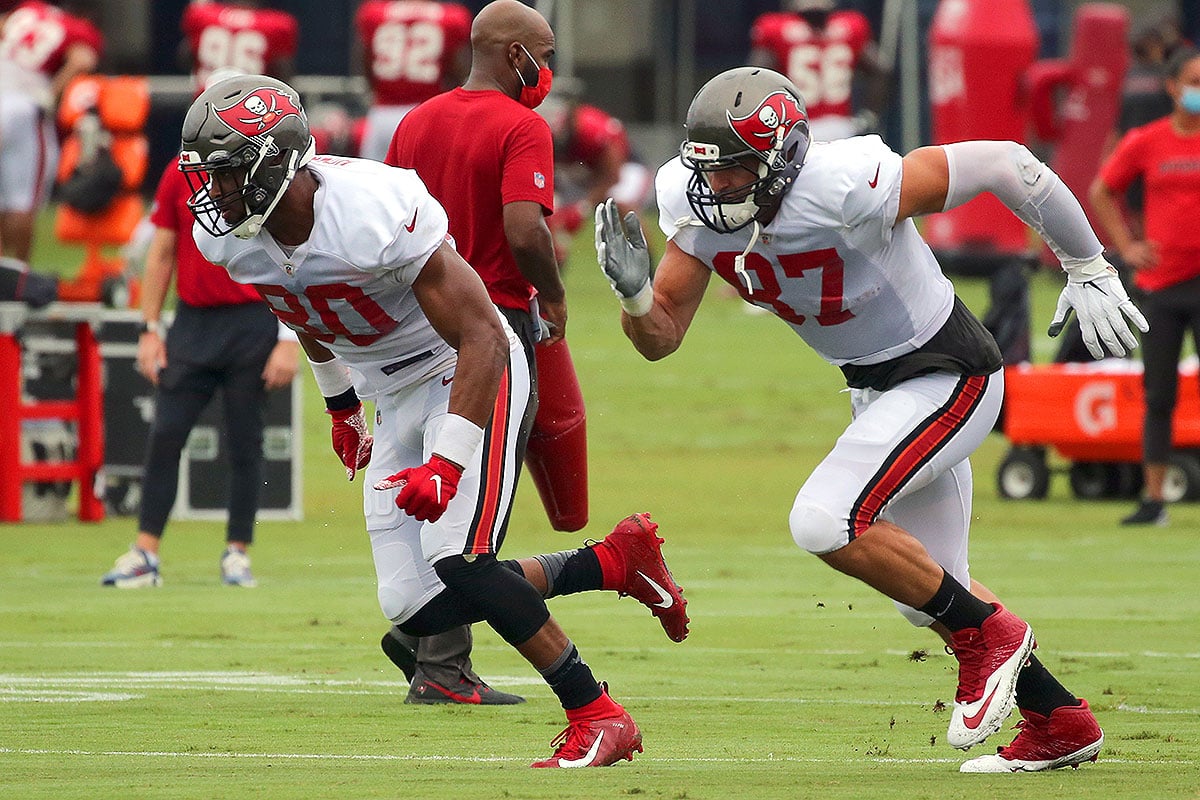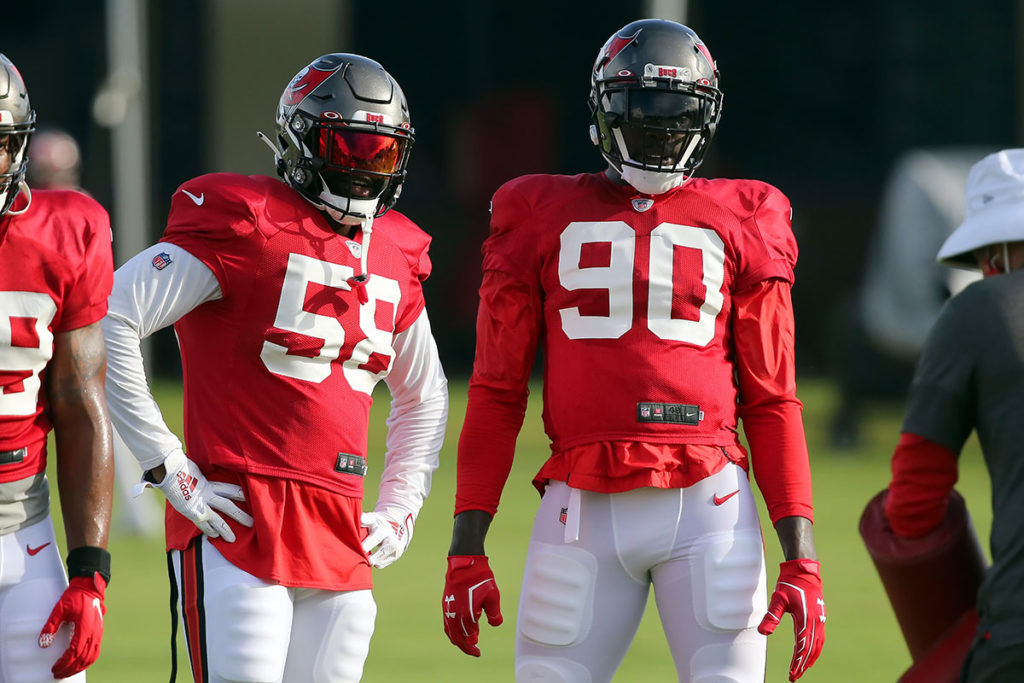Bookmakers currently price Buccaneers as the second favorite team to win Super Bowl. Draftkings, one of the most popular US bookies currently licensed in 11 states, offers odds +600 for a back-to-back win. If you’re looking for an even safer bet, the production of Tampa Bay’s tight end room will increase with the return of O.J. Howard from a torn Achilles. Howard’s return to action makes the Bucs tight end room is arguably the best in the league.
While Tampa Bay doesn’t have a George Kittle or a Travis Kelce, they boast three starting-caliber options at the position. We are going to look into how Arians likes to use tight ends in his offense, how successful this was in 2020 and what we could see from this group in 2021.
How Arians Uses TEs
Receiving Vs Blocking
Arians has been known to hold onto some old school mantras when it comes to football. When it comes to the tight end position, Arians is no different. Below is a table showing the percentage of receiving snaps vs blocking snaps. Notice that only one player, O.J Howard, has a higher percentage of snaps as a receiver than as a blocker. Arians likes his TEs to be high-frequency run blockers as well as pass catchers, a style the NFL seems to be moving away from in recent years.

Bucs TE Rec vs Blk % in 2020
Compare this to some of the best TEs in the league when it comes to receiving. I’m not saying the Bucs options are as good as the league’s top three tight ends when it comes to receiving. But Gronkowski certainly is not far behind. None of the league’s best tight ends have more blocking snaps than receiving.

League Best TE Rec vs Blk % in 2020
The question is, are the Bucs fully maximizing their tight end receiving talent? Before getting injured, O.J Howard had the seventh-highest receiving grade for a TE per PFF. He averaged 13+ yards per reception and two TDs in four games. And he did all that while averaging less than three targets per game! It’s hard to get everyone enough snaps or targets in this offense, but Howard’s production per opportunity suggests he could thrive in a larger receiving role.
Alignment Of The Bucs TEs
How is the alignment of the Bucs tight ends impacting their receiving potential? Below is the alignment percentage breakdown of each TE. This shows how often they were in-line or flexed out in the slot/out wide.

Bucs TE Alignment % in 2020
All three tight ends saw the vast majority of their snaps attached to the formation. This is particularly evident in Gronkowski’s situation. He was used in pass protection 100+ times in 2020, second most in the league. In the table above, I have included Gronkowski’s numbers from his 2017 All-Pro season. This displays the vast difference in his usage with Tampa Bay compared to his time in New England.
Singling their tight ends out wide in a 3×1 formation could be one of the best ways to create matchup problems for defenses facing the Bucs in 2021. Doing this in a 2-minute offense would also give Brady an excellent man-zone read without having to use motion. If a flexed tight end is covered by a corner, the defense is more likely to play zone. If a linebacker or safety aligns across from them, Brady is more likely to see man coverage.
In the red zone, things change however. Against the Las Vegas Raiders, Gronk is isolated in a 3×1 formation. The Raiders choose to defend Gronkowski with an undersized corner in man coverage. Regardless of what route Gronkowski runs, this is a pre-snap matchup that Brady knows he will attack. In this instance, it’s a back-shoulder fade for a touchdown.

Gronkowski singled in a 3×1 formation vs Raiders
One reason the Bucs used their tight ends in-line so much was the lack of pass protection ability from the running back position. The use of 6-7 man protections was prevalent after the bye week, even including the “Jumbo 12” package, utilizing a sixth offensive lineman. The addition of Giovani Bernard and a better understanding of pass protection for Leonard Fournette and Ke’Shawn Vaughn should hopefully ease this problem. This may allow the Bucs to flex out their TE at a greater rate in 2021.
The in-line alignment is perfect for targeting the TE position off of play-action passes. It helps sell the run fake and gets the defender stepping down before dropping into coverage. In-line play-action passes on concepts such as Y-Cross are deadly and are simple concepts to install. Seen below is the Y-Cross concept off play-action. This is very similar to the Bucs ‘Go’ concept, and would be a great change-up play to compliment it from play-action.

Y-Cross off play-action vs Denver 2017
However, as discussed previously, the Bucs didn’t run a significant amount of play-action. Even with the dramatic increase after the bye week, they still finished below the league average for the season at 21 percent. Not to mention, of the play-action passes they ran after the bye week, only 24 percent went to a tight end. With Arians offense being so WR-centric, it is going to be difficult for any of the Bucs TEs to produce at a league-leading level, like Gronkowski did in 2017.
What To Expect In 2021
Rob Gronkowski
Gronkowski will remain TE1 for the Bucs in 2021, after playing 1,032 snaps last season. His ability as a run and pass blocker give him the versatility that Howard and Brate simply don’t possess. That is significant in a Bruce Arians offense. Despite good, not great production in 2020, Gronkowski can still get open deep on a regular basis. He’s still a matchup nightmare and provides Brady with a 6-6 target in the red zone.
O.J. Howard
With Howard returning from injury, it is paramount that he hit the ground running at camp. He needs practice to get back in football condition. Remember, it took Gronkowski four weeks or so to become himself again, and Gronk wasn’t recovering from anything as serious as an Achilles tear.
In terms of Howard’s role, he saw the highest percentage of snaps as a flexed receiver. It’s clear that Brady and the coaching staff, see him as a legit receiving threat in the pass game. Thanks to the presence of Gronkowski, the Bucs are able to play more to Howard’s strengths as a weapon, while Gronk handles more of the in-line work.
Cam Brate
If you want to know how WR-centric the Bucs offense was at the start of the year, look no further than Week 8. The Bucs played the New York Giants, and Howard and Chris Godwin were out of the lineup. Still, Cam Brate played just 12 snaps, compared to 44 snaps for Jaydon Mickens. The Bucs coaches simply tried to replace the role of Godwin without opting for more 2-tight end sets despite Brate’s superiority to Mickens as a player. Tampa Bay could have taken advantage of two of the worst coverage linebackers in the league in Reggie Ragland and rookie Tae Crowder.
This philosophy changed by the time the Bucs got to the playoffs. Brate was one of the Bucs most productive offensive weapons during the 4-game stretch. In 2021, Brate should be used like he was in the playoffs. Arians and offensive coordinator Byron Leftwich opened him up on crossing routes off play-action and short hitches and stick routes vs zone coverages. Brate’s ability to work from an in-line or flexed alignment is another positive.
The beauty with having Brate is that the Bucs can sustain an injury in their tight end room and not lose out on receiving production. Brate is comfortable in his role as TE3, but can come off the bench and give you 80 yards and a touchdown any week. The trick will be finding him playing time if everyone is healthy. Brate doesn’t offer much as a blocker, which limits his usefulness in run-heavy personnel.
Jack Barrett is Pewter Report's newest contributor, bringing a knowledge of advanced analytics to the team. Jack prides himself on not only understanding and articulating the game from an X’s and O’s standpoint, but also providing eye-opening stats to educate fans on the intricacies of the game.
Hailing from the U.K., Jack is fairly new to the NFL world. His first-ever football game was Tom Brady's miraculous comeback over the Falcons to win Super Bowl LI. From that point forward, Jack has quickly acclimated himself to the NFL game through rigorous study and viewership.
Jack's other interests include soccer, which he played at a collegiate level, cooking and fashion. He’s looking forward to providing Buccaneers fans with unique content and analysis to deepen readers knowledge of the team.




